This document provides an overview of Scrum and the roles of Product Owner and Product Backlog. It describes Scrum as an iterative, incremental framework for project management and agile software development. The key roles in Scrum are the ScrumMaster, Product Owner, and cross-functional Team. The Product Owner represents stakeholders and the business, prioritizing and ensuring delivery of the Product Backlog.








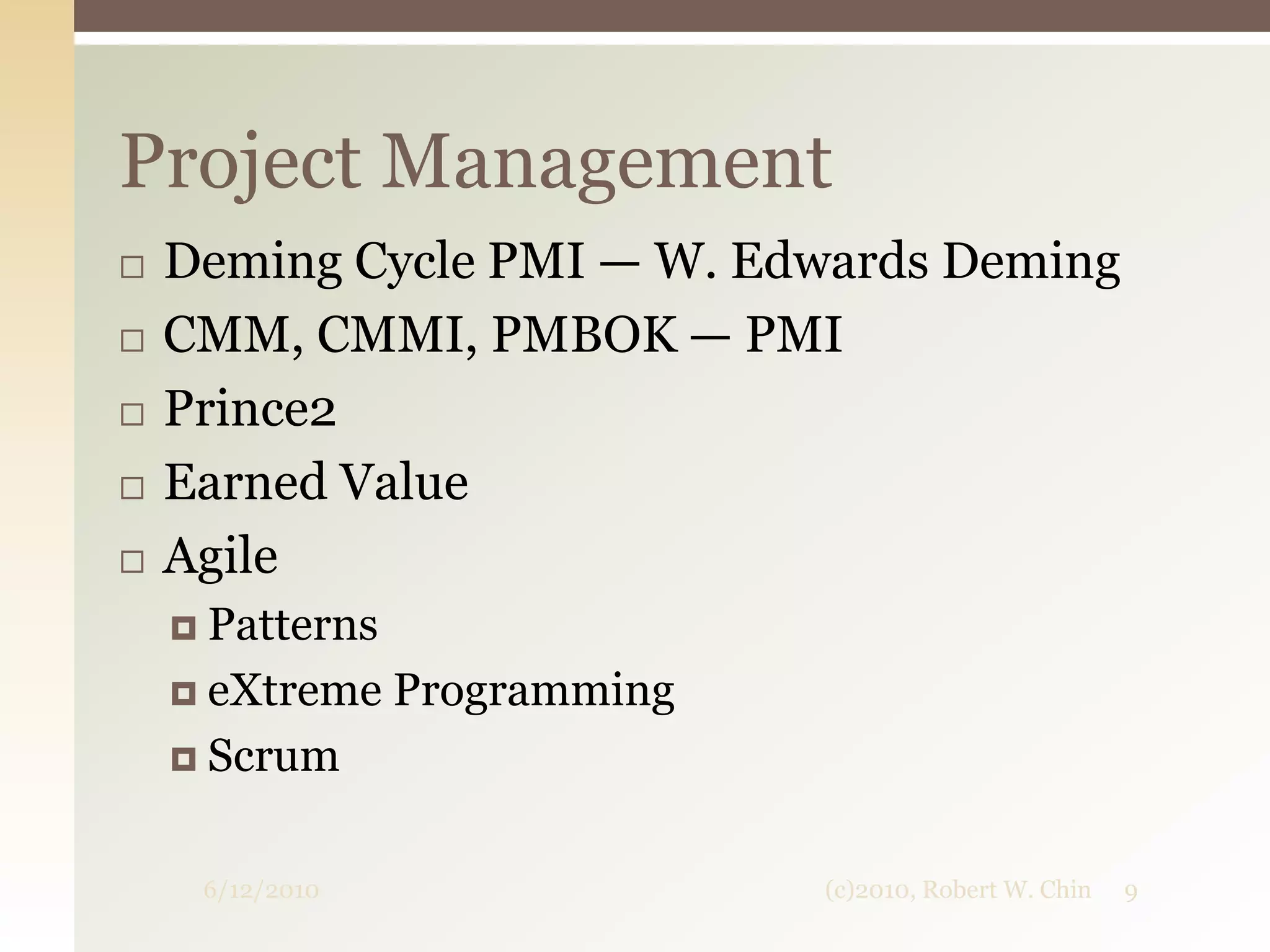
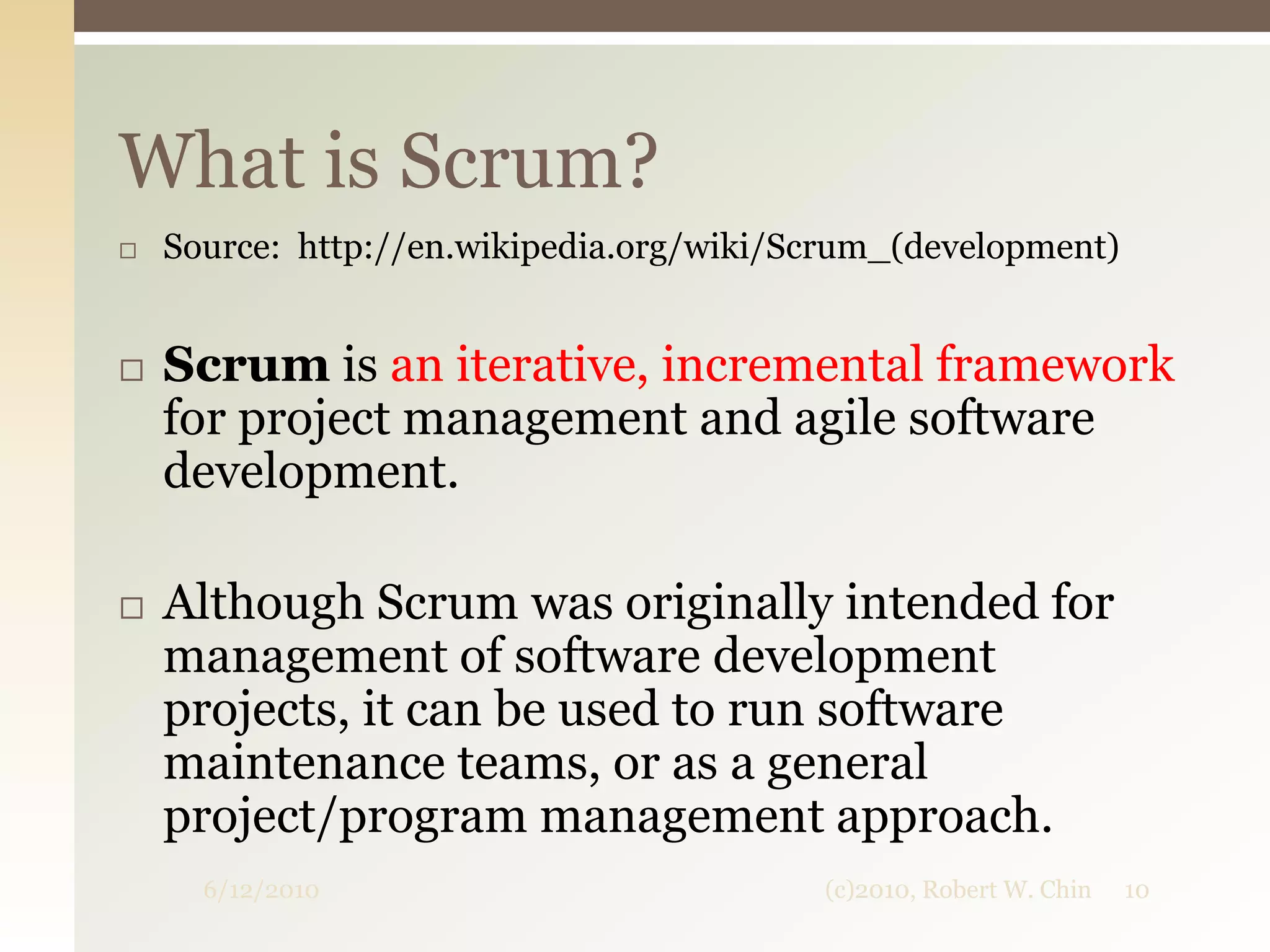




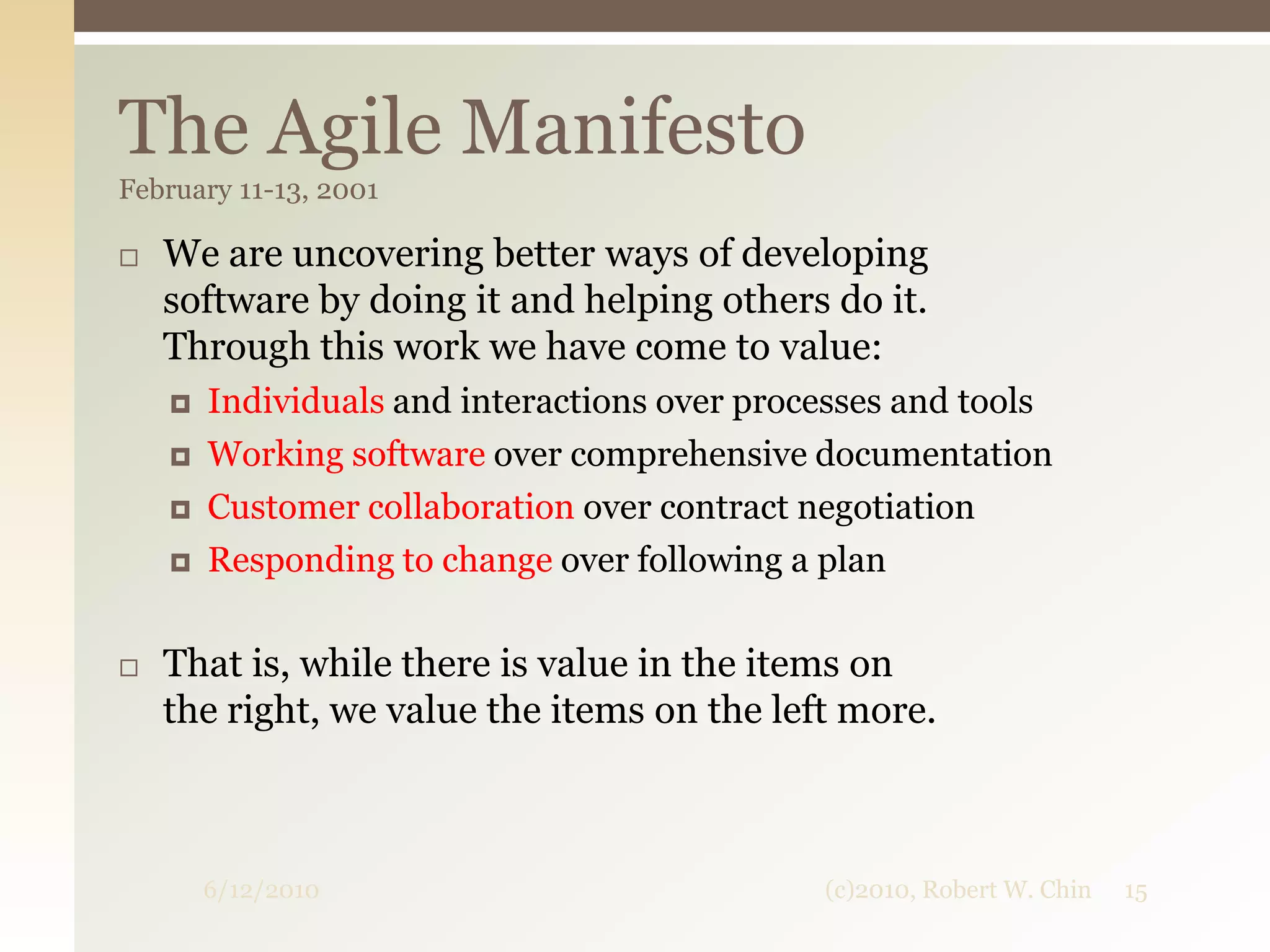


![1.^ a b Schwaber, Ken (1 February 2004). Agile Project Management with Scrum. Microsoft Press. ISBN 978-0-735-61993-7. 2.^ Takeuchi, Hirotaka; Nonaka, Ikujiro (January-February 1986). "The New New Product Development Game" (PDF). Harvard Business Review. http://apln-richmond.pbwiki.com/f/New%20New%20Prod%20Devel%20Game.pdf. Retrieved 2008-09-26. [dead link]3.^ DeGrace, Peter; Stahl, Leslie Hulet (1 October 1990). Wicked problems, righteous solutions. Prentice Hall. ISBN 978-0-135-90126-7. 4.^ Sutherland, Jeff (October 2004). "Agile Development: Lessons learned from the first Scrum" (PDF). http://www.scrumalliance.org/resources/35. Retrieved 2008-09-26. 5.^ "The Classic Story of the Pig and Chicken". Implementing Scrum. 11 September 2006. http://www.implementingscrum.com/2006/09/11/the-classic-story-of-the-pig-and-chicken/. Retrieved 2010-04-03. 6.^ Schwaber, p. 77.^ "Scrum, Scrum Developer Courses, Scrum Knowledge Assessment, Scrum Guide, Ken Schwaber - Scrum Guides". Scrum.org. 2009. http://www.scrum.org/scrumguides/. Retrieved 2010-04-03. 8.^ Schwaber, p. 1359.^ Cohn, Mike (May 2007). "Advice on Conducting the Scrum of Scrums Meeting". http://www.scrumalliance.org/articles/46-advice-on-conducting-the-scrum-of-scrums-meeting. Retrieved 2009-07-23. 10.^ Schwaber, p. 13311.^ Sprint, Planning (January-February 2009). Sprint Planning Rules. http://www.sprintplanning.com/SprintPlanningRules.aspx. Retrieved 2009-03-30. 12.^ Schwaber, p. 13713.^ Schwaber, p. 13814.^ Invented by Mike Cohn, more info can be found here [1]15.^ Schwaber, pp. 141–14316.^ p.5 Crisp.se17.^ Leansoftwareengineering.com18.^ a b Leansoftwareengineering.com19.^ p.18 - 19 Crisp.se20.^ p.22 - 23 Crisp.se21.^ Infoq.com (The video and the summary)Referenceshttp://en.wikipedia.org/wiki/Scrum_(development)6/12/201010(c)2010, Robert W. Chin](https://image.slidesharecdn.com/scrumoverview-100612123213-phpapp01/75/Scrum-Overview-18-2048.jpg)
![In 1986, Hirotaka Takeuchi and IkujiroNonaka described a new holistic approach that would increase speed and flexibility in commercial new product development.[2] They compared this new holistic approach, in which the phases strongly overlap and the whole process is performed by one cross-functional team across the different phases, to rugby, where the whole team “tries to go to the distance as a unit, passing the ball back and forth”. The case studies came from the automotive, photo machine, computer and printer industries.History6/12/201011(c)2010, Robert W. Chin](https://image.slidesharecdn.com/scrumoverview-100612123213-phpapp01/75/Scrum-Overview-19-2048.jpg)
![In 1991, DeGrace and Stahl, in “Wicked Problems, Righteous Solutions,”[3] referred to this approach as Scrum, a rugby term mentioned in the article by Takeuchi and Nonaka. In the early 1990s, Ken Schwaber used an approach that led to Scrum at his company, Advanced Development Methods. At the same time, Jeff Sutherland, John Scumniotales, and Jeff McKenna developed a similar approach at Easel Corporation and were the first to call it Scrum.[4] History (continued)6/12/201012(c)2010, Robert W. Chin](https://image.slidesharecdn.com/scrumoverview-100612123213-phpapp01/75/Scrum-Overview-20-2048.jpg)
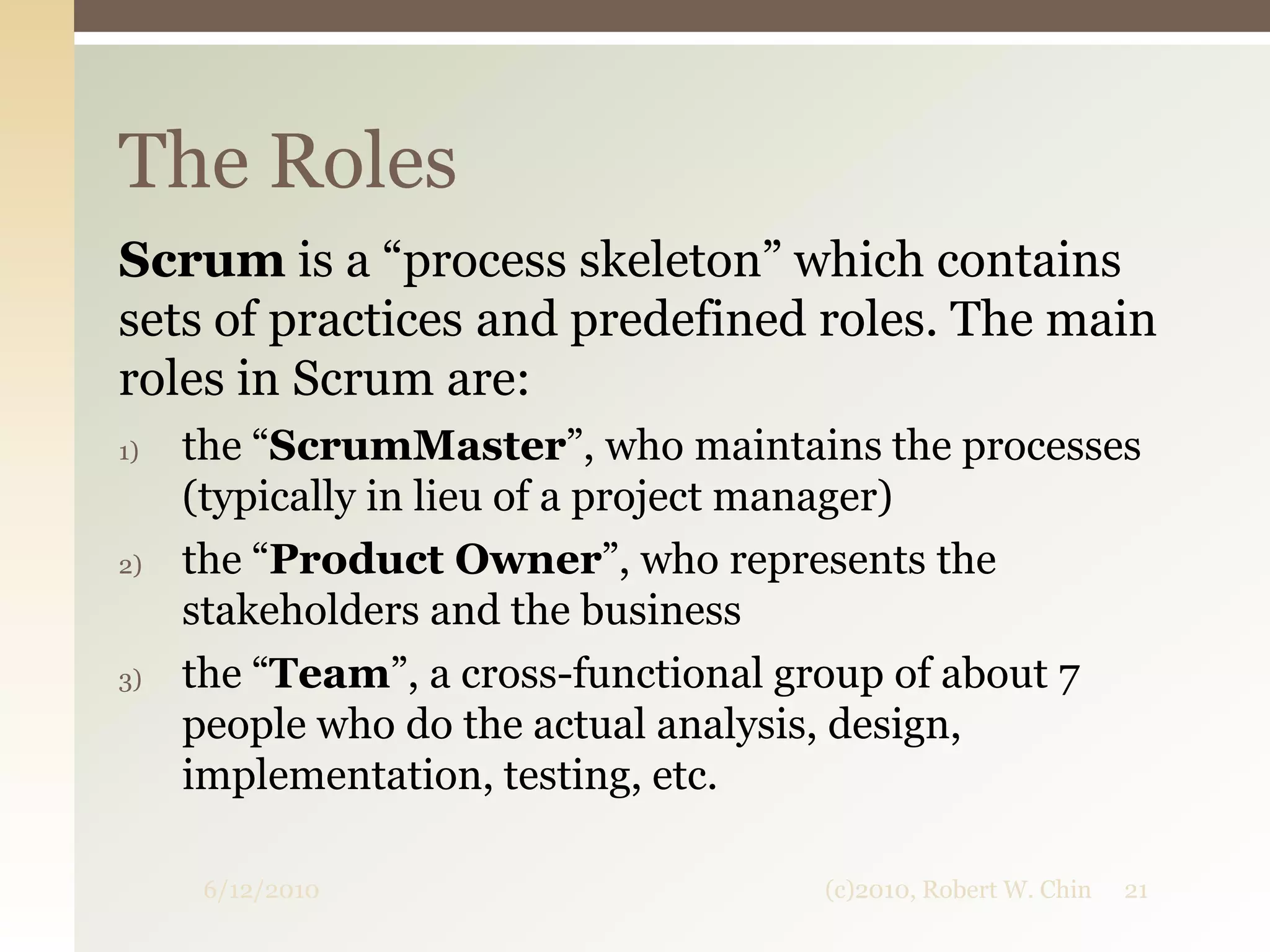




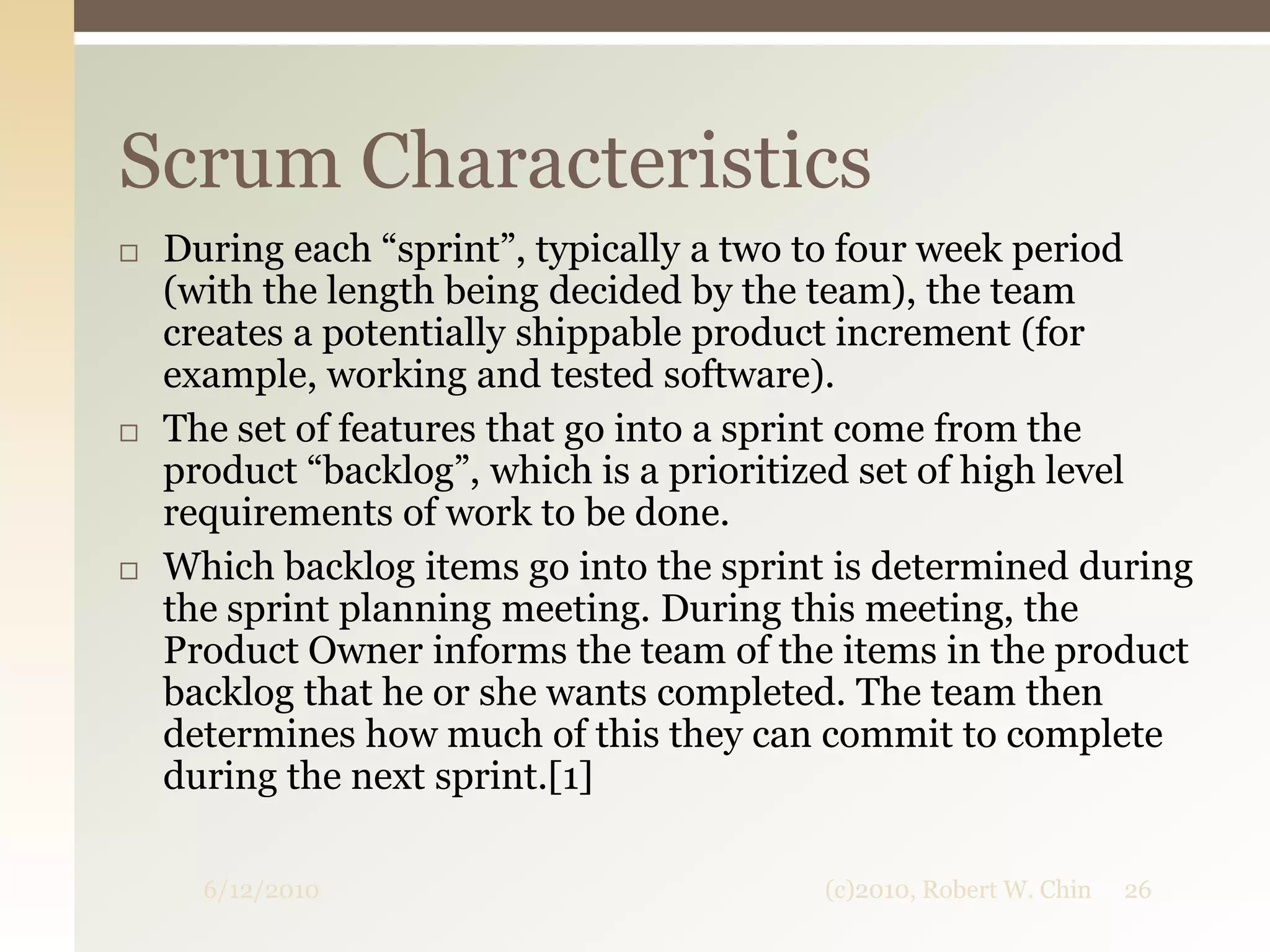
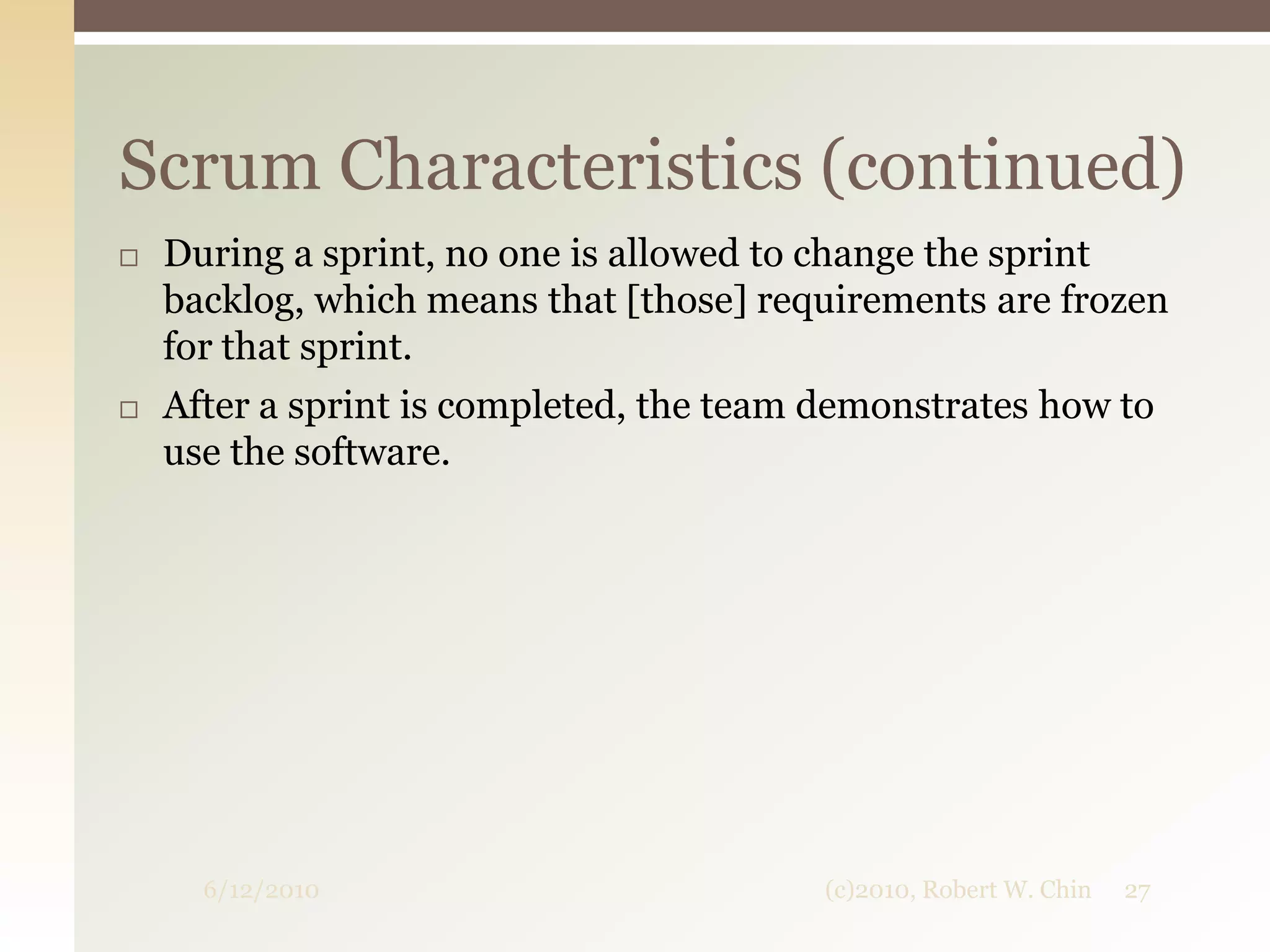

![The Pigs are the ones committed to the project in the Scrum process—they are the ones with “their bacon on the line” and performing the actual work of the project.ScrumMaster (or Facilitator)Scrum is facilitated by a ScrumMaster, whose primary job is to remove impediments to the ability of the team to deliver the sprint goal/deliverables. The ScrumMaster is not the leader of the team (as the team is self-organizing) but acts as a buffer between the team and any distracting influences. The ScrumMaster ensures that the Scrum process is used as intended. The ScrumMaster is the enforcer of rules. A key part of the ScrumMaster’s role is to protect the team and keep them focused on the tasks in hand.TeamThe team has the responsibility to deliver the product. A team is typically made up of 5–9 people with cross-functional skills who do the actual work (design, develop, test, technical communication, etc.).Product OwnerThe Product Owner represents the voice of the customer. He/she ensures that the Scrum Team works with the “right things” from a business perspective. The Product Owner writes customer-centric items (typically user stories), prioritizes them and then places them in the product backlog. A Product Owner can be a member of the Scrum Team but cannot be a ScrumMaster.[7]According to original Scrum, Product Owner is in a "pig" role. However, if the Product Owner does not have involvement regularly, he/she may be considered as a "chicken" .“Pig” Roles in Scrum6/12/201021(c)2010, Robert W. Chin](https://image.slidesharecdn.com/scrumoverview-100612123213-phpapp01/75/Scrum-Overview-29-2048.jpg)
![Stakeholders (customers, vendors) These are the people who enable the project and for whom the project will produce the agreed-upon benefit[s], which justify its production. They are only directly involved in the process during the sprint reviews. Managers People who will set up the environment for the product development organizations.“Chicken” Roles6/12/201022(c)2010, Robert W. Chin](https://image.slidesharecdn.com/scrumoverview-100612123213-phpapp01/75/Scrum-Overview-30-2048.jpg)
![During each “sprint”, typically a two to four week period (with the length being decided by the team), the team creates a potentially shippable product increment (for example, working and tested software). The set of features that go into a sprint come from the product “backlog”, which is a prioritized set of high level requirements of work to be done. Which backlog items go into the sprint is determined during the sprint planning meeting. During this meeting, the Product Owner informs the team of the items in the product backlog that he or she wants completed. The team then determines how much of this they can commit to complete during the next sprint.[1]Scrum Characteristics6/12/201023(c)2010, Robert W. Chin](https://image.slidesharecdn.com/scrumoverview-100612123213-phpapp01/75/Scrum-Overview-31-2048.jpg)
![During a sprint, no one is allowed to change the sprint backlog, which means that [those] requirements are frozen for that sprint. After a sprint is completed, the team demonstrates how to use the software.Scrum Characteristics (continued)6/12/201024(c)2010, Robert W. Chin](https://image.slidesharecdn.com/scrumoverview-100612123213-phpapp01/75/Scrum-Overview-32-2048.jpg)

![At the beginning of the sprint cycle (every 7–30 days), a “Sprint Planning Meeting” is held. Select what work is to be donePrepare the Sprint Backlog that details the time it will take to do that work, with the entire teamIdentify and communicate how much of the work is likely to be done during the current sprintEight hour limit (1st four hours) Product Owner + Team: dialog for prioritizing the Product Backlog(2nd four hours) Team only: hashing out a plan for the Sprint, resulting in the Sprint BacklogMeetings – Sprint Planning Meeting[10][11]6/12/201026(c)2010, Robert W. Chin](https://image.slidesharecdn.com/scrumoverview-100612123213-phpapp01/75/Scrum-Overview-34-2048.jpg)
![Scrum of scrums Held each day, normally after the daily scrum. These meetings allow clusters of teams to discuss their work, focusing especially on areas of overlap and integration.A designated person from each team attends.The agenda will be the same as the Daily Scrum, plus the following four questions:[9] What has your team done since we last met?What will your team do before we meet again?Is anything slowing your team down or getting in their way?Are you about to put something in another team’s way?Meetings – The Daily Scrum 6/12/201027(c)2010, Robert W. Chin](https://image.slidesharecdn.com/scrumoverview-100612123213-phpapp01/75/Scrum-Overview-35-2048.jpg)
![Scrum of scrums Held each day, normally after the daily scrum. These meetings allow clusters of teams to discuss their work, focusing especially on areas of overlap and integration.A designated person from each team attends.The agenda will be the same as the Daily Scrum, plus the following four questions:[9]What has your team done since we last met?What will your team do before we meet again?Is anything slowing your team down or getting in their way?Are you about to put something in another team’s way?Meetings - Scrum of Scrums6/12/201028(c)2010, Robert W. Chin](https://image.slidesharecdn.com/scrumoverview-100612123213-phpapp01/75/Scrum-Overview-36-2048.jpg)
![At the end of a sprint cycle, two meetings are held: the “Sprint Review Meeting” and the “Sprint Retrospective”Sprint Review Meeting [12] Review the work that was completed and not completedPresent the completed work to the stakeholders (a.k.a. “the demo”)Incomplete work cannot be demonstratedFour hour time limitSprint Retrospective [13] All team members reflect on the past sprintMake continuous process improvementsTwo main questions are asked in the sprint retrospective: What went well during the sprint? What could be improved in the next sprint?Three hour time limitMeetings – “Sprint Review Meeting” and the “Sprint Retrospective”6/12/201029(c)2010, Robert W. Chin](https://image.slidesharecdn.com/scrumoverview-100612123213-phpapp01/75/Scrum-Overview-37-2048.jpg)

![A key principle of Scrum is its recognition that during a project the customers can change their minds about what they want and need (often called requirements churn), and that unpredicted challenges cannot be easily addressed in a traditional predictive or planned manner. As such, Scrum adopts an empirical approach—accepting that the problem [may not or] cannot be fully understood or defined, focusing instead on maximizing the team’s ability to deliver quickly and respond to emerging requirements.Highlight Point #26/12/201031(c)2010, Robert W. Chin](https://image.slidesharecdn.com/scrumoverview-100612123213-phpapp01/75/Scrum-Overview-39-2048.jpg)


